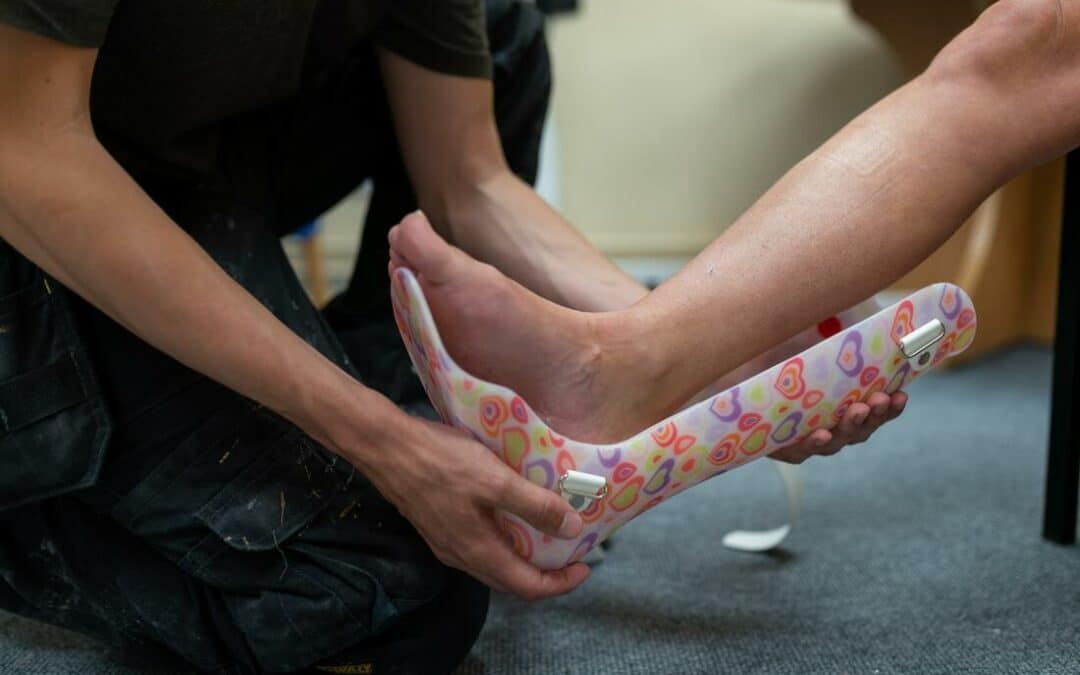Many different types of orthoses and braces serve many different purposes. Spine alignment braces can help those who have scoliosis, cervical orthoses help support your neck and chin, and knee orthoses can help you heal after knee surgery.
However, the most popular type of orthoses is AFO, making up over 26% of all orthoses provided in the US. But what is an AFO exactly? And more importantly, how do you wear and maintain it properly? Let’s take a closer look to find out.
What Is AFO?
AFO is short for an ankle-foot orthosis. It’s a type of brace that’s designed for the ankle and foot area and is prescribed to help treat and manage a variety of different conditions. It’s primarily used in treating conditions such as physical deformity, cerebral palsy, spina bifida, and muscular dystrophy. However, it can also be prescribed after foot or ankle surgery to promote healing.
AFO aims to provide better stability and support, and it comes in many different shapes and sizes. Your prosthetist could prescribe one of the following types of AFO depending on your condition:
- Solid ankle-foot orthosis – used for more severe conditions where the ankle and foot need to be firmly stabilized;
- Hinged ankle-foot orthosis – allows for more ankle mobility and flexibility, but stabilizes the foot;
- Leaf Spring ankle-foot orthosis – offers the greatest mobility and is barely visible under clothing.
No matter the type of AFO you’re using, you need to know how to wear and maintain it properly. So, let’s take a look.
How to Wear AFO
Once you’ve been prescribed an AFO, you’ll have to wear it almost constantly. You’ll likely depend on it daily, so you want to ensure that it’s as comfortable as possible.
1. Don’t Wear an AFO 24/7. Even if you need to wear your AFO for the majority of the day, you must start slowly. Regardless of how lightweight or hefty your AFO is, it will cause significant discomfort if you never take it off.
You’ll minimize pain and skin irritation by giving your body time to get used to the brace. This means wearing your AFO for about an hour at first, then allowing yourself to rest. You can alternate between wearing the brace and resting for the first few days.
2. Don’t Fiddle Around with Your AFO. It’s relatively easy adjusting your AFO yourself, but this isn’t recommended. Whether your AFO ankle brace is custom-made or not, your orthotist has already adjusted it to suit you.
Typically, your AFO will cause discomfort at first, and it will take time for you to get used to walking around with it and relying on it entirely. Be patient. Adjusting the AFO yourself will not help you get used to it anytime sooner.
If you believe that any adjustments should be made, call your orthotist and see how they can help you.
3. Find the Right Shoes. Most AFOs can be easily worn with shoes, but not any kind of shoe will work for you. First of all, you’ll likely need to get shoes that are a size or two bigger than usual. That way, you’ll avoid putting unnecessary pressure on your ankle and foot.
Second, it’s best to wear your AFO with lace-up shoes, as you’ll be able to adjust how tight they are.
Of course, never wear your AFO with high heels, as this will impact the effectiveness of your brace. It’s best to get flat shoes with the entire heel at the same height.
4. Wear Cotton Socks. Socks will help your AFO feel more comfortable and will prevent redness and pressure points on your skin. As a general rule of thumb, you should opt for thicker socks since they can act as cushioning for the brace.
The best material for socks would be cotton or wool. These fabrics are breathable, will prevent excessive sweating, and will help you feel more comfortable.
To prevent the socks from riding down and exposing your skin to the hard material of your AFO, opt for longer socks that you can fold over the brace.
How to Maintain Your AFO
It’s pretty easy maintaining your AFO as it’s made of durable materials that can withstand normal wear. There are only a few things you’ll need to pay attention to.
1. Clean Once a Week. Since you’ll constantly be wearing your AFO, you need to clean it regularly to prevent bacteria build-up. At the very least, you should clean it once a week.
You’ll need to do it by hand, and all you’ll need is some mild soap and water. Don’t use any strong chemicals or bleach as this can damage the brace. Also, avoid soaking your AFO in water and leaving it there, especially if it has metal parts.
Simply use a damp towel to clean off the AFO, and rinse it thoroughly afterward.
2. Let It Dry Properly. Once you’ve cleaned your AFO, you’ll need to dry it off completely. It’s best to tap it dry with a clean towel then set it aside to air dry completely.
Don’t expose your AFO to direct heat. Don’t leave it next to the fireplace or space heaters, and don’t use hair dryers on it. AFOs can be easily damaged when exposed to direct heat. At best, you can use a fan to dry them off – it’s not the quickest solution, but it’s the safest.
3. Don’t Forget to Lubricate the Brace. If your AFO has metal joints, you’ll need to lubricate them occasionally. Talk to your orthotist about which lubricant to use and how often to use it.
They’ll help you create the best lubrication schedule that will keep your AFO functional and comfortable.
The Bottom Line
AFOs aren’t too difficult to wear and take care of, all it takes is some getting used to. If you aren’t sure whether you’re wearing and maintaining your device correctly, talk to your orthotist. They’re the ones who are best-equipped to help you.




